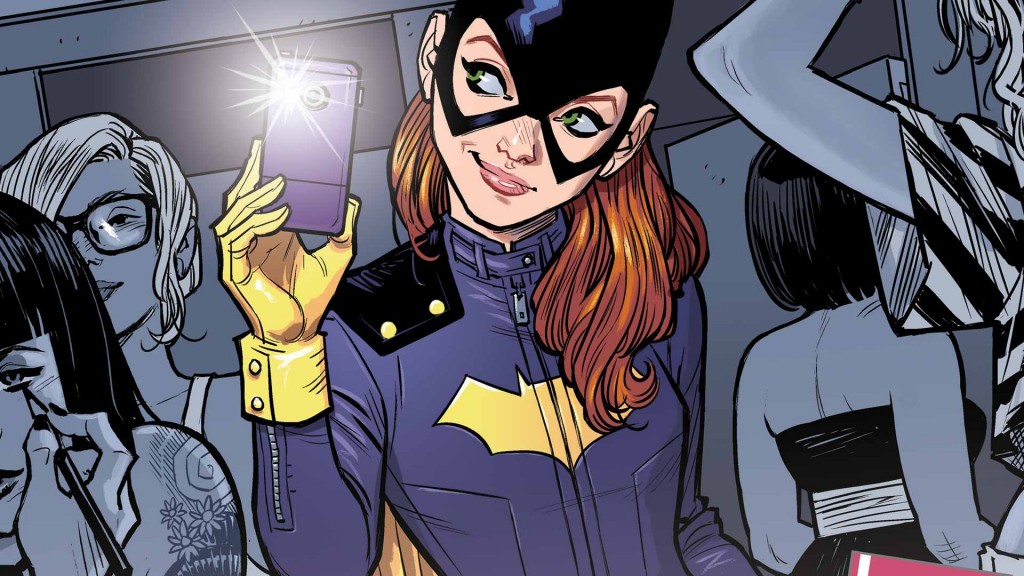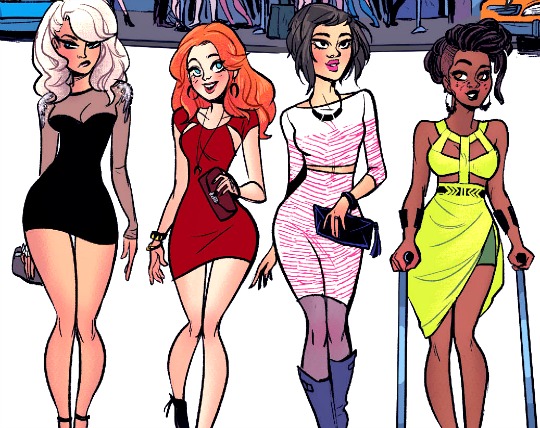The Batgirl of Burnside from Cameron Stewart, Brenden Fletcher and Bab Tarr not only chronicles some major changes for Barbara Gordon but also proves that readers are craving advancement and diversity within the comic book industry.
DC is no stranger to revamps considering their major overhaul back in 2011 with the New 52, but it seems like they are just now hitting their stride as far as modernizing characters and attempting to serve a more diverse audience. This new version of Batgirl, brought to life by an incredibly talented and cohesive creative team, comes with a makeover and a move, as Barbara relocates away from Gotham proper to the trendy borough of Burnside. A fire destroys her old costume and equipment, so she embraces a phoenix-like transformation, emerging with an amazing new suit designed by the breathtakingly talented Babs Tarr.
Tarr’s artwork, complimented perfectly by Maris Wicks’ beautifully vibrant colors, is so defining for this comic and the direction it takes. Tarr populates Burnside with twentysomethings who dress in current, recognizable fashion, and she takes the time to style each character according to their personality. Guys have perfectly quaffed pompadours and curled mustaches, and the ladies shave the sides of their heads and wear dresses that I swear I’ve seen in real life. It’s almost a little too perfect, bordering on someone’s idealized vision of Brooklyn, but it really works, especially because every character is unique. Tarr’s talent also expands into the storytelling, especially in splash pages that guide your eye without traditional panels.
The artwork isn’t the only aspect of the comic that attempts to keep up with the times. Writers Cameron Stewart and Brenden Fletcher valiantly incorporate popular apps such as Instagram and Tinder (using fictional names that fit a fictional city) into the comic as surprisingly relevant plot points, so much so that it almost feels like it’s pandering to people who use those services in real life. However, with such intelligent and tech-savvy ladies, like Barbara and Frankie, driving the story, it makes sense to have them innovating technology on a such a relatable level.
This new version of Batgirl, along with titles such as Grayson and Gotham Academy, is part of a family of comics referred to as “Young Gotham”. While not necessarily catering to young readers only, DC touts these titles as “a Gotham for everyone,” ingeniously using Batman—arguably their most popular character—as a launchpad for a new generation of storytelling. In contention with this idea of a Gotham for everyone is a perspective put out by Comics Alliance alongside the premiere of Batgirl #35 last year. This perspective declares definitively that Batgirl, specifically this version of her, is “for girls,” and that boys can simply leave well enough alone. Of course, the glaring irony of proclaiming this comic to be for girls only is that it wasn’t even written by girls. Two dudes wrote this comic, two particularly talented and respectable dudes, but dudes nonetheless. It’s like establishing a girls-only clubhouse and letting some guys write the rules.
This “girls only” idea rubs me the wrong way. In my mind, it’s no different than when I was in kindergarten and a boy told me that green could not be my favorite color because I was a girl. I don’t particularly like it when we over-genderize things, and I don’t like the us vs them mentality that comes across in this way of thinking. I also have to disagree with the “Batgirl is for girls” schtick because, as a girl, I found that this new Batgirl was perhaps not for me.
This doesn’t mean that I don’t think this is a great book! Nor does it mean I don’t appreciate what DC was trying to accomplish. (I have to admit, however, I did find myself rolling my eyes just a little with Dinah as she snapped a pic of Barbara in costume for Batgirl’s new Instagram account). Maybe I just don’t get kids these days. I’m approaching my late twenties, so you could assume that maybe I’ve outgrown this character. But at the same time, I still find myself relating to other teen superheroes, such as G. Willow Wilson’s Ms. Marvel, and Barbara Gordon has always been my favorite comic book character.
The issue for me is the distracting way in which Barbara is suddenly treating her friends, specifically Dinah, at the beginning of Burnside. The fire that consumed Batgirl’s old costume also destroyed Black Canary’s, well, everything, and it turns out to be Barbara’s fault. Instead of supporting her ally, she gives Dinah a non-apology (“you’re gonna hate me but….I think the fire was my fault. Um. I’m so sorry…”) and treats her like a burden. Barbara has always been fiercely loyal to her friends. After all, this is the woman who obtained a law degree while in a wheelchair to help Bruce Wayne when he was accused of murder. It’s out of character for her to be so wrapped up in her own problems that she complains about losing her equipment to her friend whose house she burned down. Granted, her petulant attitude is a part of her character arc in this volume, and it is finally addressed in the last few chapters, but it takes so long to get to that point that I honestly stopped buying the comic as it came out. It became too much of a chore to root for the hero.
Amy Poehler says that women should practice the mantra, “Good for her, not for me” when finding contention with something that others enjoy so fiercely. So, let me go back to those final issues of this arc, as well as Secret Origins #10, and talk about the good. All problems aside, this story arc pays more homage to Barbara’s journey as Oracle than any Batgirl storyline in the New 52 thus far. The infamous and controversial events of The Killing Joke left Barbara paralyzed for over 20 years, until the big Five-Two healed her and reestablished her as Batgirl. Losing her legs did not kill her vigilantism during that time, however. Under the alias of Oracle, Barbara became an even more essential asset to the Bat Family as a skillful hacker, and she went on to lead her own team in Birds of Prey. Many readers, myself included, were sad to lose Oracle, and it feels like The Batgirl of Burnside finally allows Barbara to find real closure with this chapter of her life in a surprising way. There’s even a teeny tiny hint that one of Barbara’s friends may take over the role of Oracle. Despite Barbara’s problematic attitude, the story culminates with a fist-pumping conclusion that’s got me amped for Batgirl’s next chapter (not to mention Black Canary’s spin-off).
The success of this comic is due in large part to a creative team that listens to its fans. They populated this story with strong, diverse characters, and they even changed a line of dialogue for this collected volume after readers voiced concerns that it was transphobic. I may have a few qualms with the new Batgirl, but that doesn’t mean that she’s not groundbreaking. The Batgirl of Burnside features a strong female protagonist, trendy fashion, hot guys, a bitchin’ new costume, and some major girl power, but don’t get it twisted—this comic is for everyone (everyone who wants to read it, at least).
Batgirl v.1: The Batgirl of Burnside is available now online, at booksellers, and at your local comics shop.




